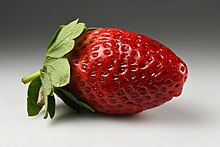**1. Cultivation and Production:**
– Garden strawberry first bred in Brittany, France in the 1750s.
– Cultivars of Fragaria ananassa replaced woodland strawberry in commercial production.
– Modern strawberries are octoploid.
– China leads in world production of strawberries with 40% in 2019.
– Different cultivation methods include plasticulture and matted rows.
– Greenhouses produce strawberries off-season.
– Research on growing strawberries from seed commercially is ongoing.
– Strawberry genome sequencing was published in 2019.
– Impact of plasticulture on strawberry production.
– Cultivation practices for optimal strawberry yield.
**2. Nutrition and Health Benefits:**
– 100g of strawberries contain 33kcal energy.
– Rich source of vitamin C (71% DV) and manganese (18% DV).
– Contains essential unsaturated fatty acids in the seed oil.
– Ellagitannins, fisetin, anthocyanins, and flavonols in strawberries.
– Strawberries possess higher levels of fisetin compared to other fruits.
– Antioxidant properties of strawberries.
– Allergenic proteins present in strawberries.
– Phenolic composition in strawberries.
– Fisetin as a dietary antioxidant in strawberries.
**3. Flavor and Chemical Composition:**
– Furaneol is a key component of strawberry fragrance.
– Factors influencing strawberry flavor.
– Dimeric anthocyanins in strawberries.
– Aroma patterns in different strawberry varieties.
– Chemical analysis of fresh strawberries.
– Seasonal influence on strawberry flavor.
– Chemical compounds like esters, terpenes, and furans impact flavor.
**4. Varieties and Uses:**
– Strawberries can be consumed fresh, frozen, or made into jam.
– Used in dairy products like milk, ice cream, and yogurt.
– Popular in desserts worldwide.
– Culinary uses include cocktail garnishes and popsicles.
– Grouped by flowering habit: short-day, long-day, and day-neutral.
– On average, a strawberry has about 200 seeds.
– Different strawberry cultivars for home gardens and exhibition.
– Marketing trends and economic significance of strawberry cultivation.
**5. Pests, Diseases, and Research:**
– Approximately 200 pest species can attack strawberries.
– Diseases like powdery mildew, red stele, and gray mold affect strawberries.
– Strategies for pest management and disease prevention.
– Impact of fungal volatile organic compounds on strawberry crops.
– Broad-spectrum disease resistance research in strawberries.
– Research studies on compost enhancing antioxidant compounds in strawberries.
– Gene-edited strawberries and their impact on human health.
– Publications and resources for successful strawberry cultivation.
The garden strawberry (or simply strawberry; Fragaria × ananassa) is a widely grown hybrid species of the genus Fragaria, collectively known as the strawberries, which are cultivated worldwide for their fruit. The fruit is widely appreciated for its characteristic aroma, bright red color, juicy texture, and sweetness. It is consumed in large quantities, either fresh or in such prepared foods as jam, juice, pies, ice cream, milkshakes, and chocolates. Artificial strawberry flavorings and aromas are also widely used in products such as candy, soap, lip gloss, perfume, and many others.
| Strawberry Fragaria × ananassa | |
|---|---|

| |
| Strawberry fruit | |

| |
| Halved strawberry | |
| Scientific classification | |
| Kingdom: | Plantae |
| Clade: | Tracheophytes |
| Clade: | Angiosperms |
| Clade: | Eudicots |
| Clade: | Rosids |
| Order: | Rosales |
| Family: | Rosaceae |
| Genus: | Fragaria |
| Species: | F. × ananassa
|
| Binomial name | |
| Fragaria × ananassa | |
The garden strawberry was first bred in Brittany, France, in the 1750s via a cross of Fragaria virginiana from eastern North America and Fragaria chiloensis, which was brought from Chile by Amédée-François Frézier in 1714. Cultivars of Fragaria × ananassa have replaced, in commercial production, the woodland strawberry (Fragaria vesca), which was the first strawberry species cultivated in the early 17th century.
From a botanical point of view, the strawberry is not a berry but an aggregate accessory fruit, meaning that the fleshy part is derived not from the plant's ovaries but from the receptacle that holds the ovaries. Each apparent "seed" (achene) on the outside of the fruit is actually one of the ovaries of the flower, with a seed inside it.
In 2019, world production of strawberries was nine million tons, led by China with 40% of the total.
